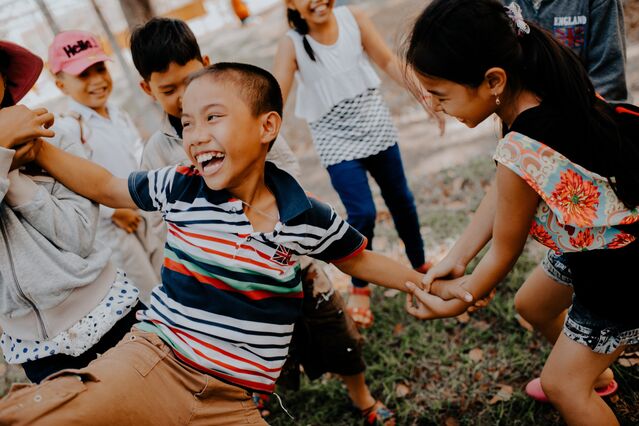Anger
Improve educational outcomes with Body Sense
Improve educational outcomes with Body Sense: ABSOLUTELY FREE!
Posted February 15, 2010

The New York Times reported recently on a pilot program that scheduled school recess before lunch, compared to the typical practice of having recess after lunch. The North Ranch Elementary school in Scottsdale, AZ conducted a year-long pilot study of this practice and found that nurse visits over the year dropped by 40% because there were fewer headaches and stomach aches. Kids ate lunch more slowly after recess because they didn't try to rush through lunch just to get outside. When recess occurred before lunch, children consumed more fruits and vegetables with less food waste and they drank more water and milk. They were calmer and more attentive during lunch and also when they returned to the classroom after lunch. Similar results have now been obtained in other states and school systems.
It's instructive to ask why such a simple, ABSOLUTELY FREE(!), intervention could work so well. The answer has to do with the psychophysiology of Body Sense, our ability to feel and stay in touch with our sensations and emotions in the present moment. Physically active play creates a feeling of joy through movement, waking children up to their bodies following a period of body disconnect during regular school activities. When the Body Sense is activated, people of all ages are more likely to relax (activation of the parasympathetic nervous system) and to effectively focus attention on the world and themselves.
Embodied self-awareness, the Body Sense, is not the same thing as having self-absorbed and ruminative thoughts. Body Sense is feeling ourselves in the present moment. Body Sense is essential for people to make healthy and self-regulatory choices about their lives including, in the case of post-recess lunch, what to eat and drink. Body sense is directly linked to a whole body psychophysiological network so that active and on-line Body Sense also heightens the production of the hormone oxytocin (relaxation, affiliation), reduces cortisol (lowered sense of stress, threat) to normal levels, enhances immune function, and activates neurotransmitters for receptors in brain areas that monitor and regulate body function and stimulate good feelings (e.g., prefrontal cortex, insula, anterior cingulated cortex, hypothalamus, brain stem).
Here are some proven, and, by the way, ABSOLUTELY FREE(!), ways to bring Body Sense into the classroom. Let's call them the THREE-Ps of Body Sense learning enhancement.
Playful Movement. We know that exercise and physical activity has beneficial effects, especially when the movement is joyful and enhances Body Sense. But kids need to move almost all the time, not just at recess or during physical education class. All children fidget during cognitive tasks in which they are required to sit still at their desks. These movements, it turns out, improve children's ability to learn and to remember. Teachers may gain a measure of control over the classroom by, counterintuitively, letting kids wiggle and move about during class. Let students sit on yoga balls, like some middle schools in Minnesota have done. Regular 5-minute breaks for walking around the classroom, stretching, jumping, wiggling, and other "warm-up" activities can do wonders for healthy body and mind functioning. It should happen in every class period. Kids enjoy wiggling. Make it fun. Do it with them. Hey, let yourself go.
Presence. Several minutes a day of meditation-like activity goes a long way toward building Body Sense, inducing relaxation, and promoting skill acquisition in the THREE-Rs. After only 6 weeks of regular yoga meditation during the school day, to take one example, children reduced their anxiety, concentrated better in school, and lowered interpersonal conflict. A 5-minute guided meditation, done while students are sitting at their desks, can bring calm and alertness in moments of classroom chaos. (Close your eyes, find a comfortable way to sit in the chair, feel your feet on the ground, feel the air on your face, notice the sounds in the room, notice your breathing, etc.). You don't need to be a Buddhist monk to lead one of these sessions as long as you are paying attention to your own body when leading and you don't rush. Give kids a minute or two to feel each thing you mention. Use a soft and soothing tone of voice. Let yourself soften and settle down. It's going to help you teach better.
Peaceful Touch. Founded in Sweden (the origin, by the way of therapeutic massage in the late 19th century), Peaceful Touch is a practice by which children are taught to give each other massages and to learn about the different types of healthy and caring touch. Peaceful Touch "integrates healthy touch into children's activities, from games and story-telling to reading, math, and science. In Sweden, where more than 300,000 children practice Peaceful Touch on a regular basis, both teachers and parents report lower levels of anxiety and aggression, and improved group functioning." (This is not completely free of cost since teachers have to be trained but the cost is extremely low compared to other continuing educational requirements for teachers. Fitting a few minutes of PT into the classroom, however, is ABSOLUTELY FREE!). Research from the University of Uppsala and Axelson's Institute in Sweden confirms that 5 to 10 minutes of Peaceful Touch on a daily basis significantly decreases aggression, reduces other social problems, improves attention, and reduces somatic health symptoms. Therapeutic and peaceful touch stimulates oxytocin, increases fellow-feelings, and above all teaches us to get in touch with our Body Sense of feeling the fundamental human need for contact, for comfort, and interpersonal support. The whole classroom will feel calmer, friendlier, safer, and, well - more in touch.
The THREE-Rs are the current standardized measures of success in school. If we are graduating kids who are stressed from fatigue, body constriction, and competition, who are anxious or depressed, who are obese or diabetic, who are not in touch with themselves nor with the people around them, all for the sake of cramming the THREE-Rs down them, then our priorities are just wrong. If you want to get schools to do their job of educating the young more efficiently and at lower cost, remember, the THREE-Ps of Body Sense learning enhancement really work and they are ABSOLUTELY FREE!


